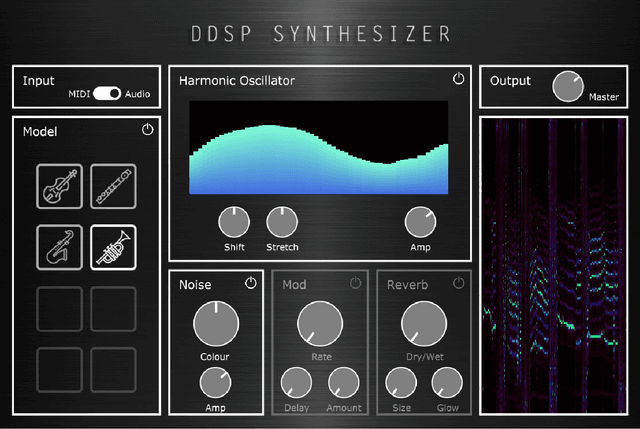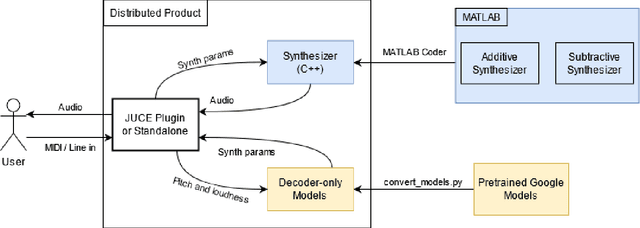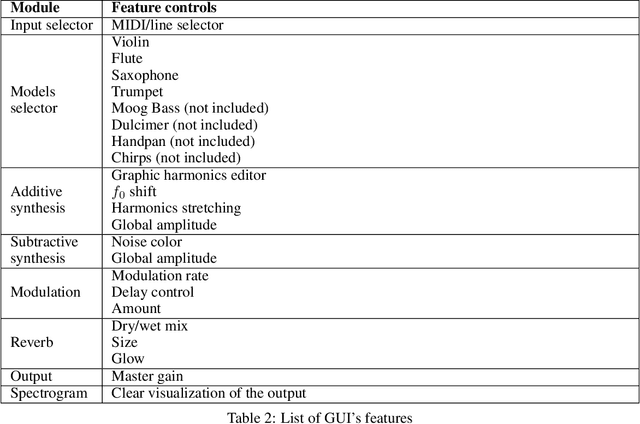David Südholt
Vocal Tract Area Estimation by Gradient Descent
Jul 10, 2023Abstract:Articulatory features can provide interpretable and flexible controls for the synthesis of human vocalizations by allowing the user to directly modify parameters like vocal strain or lip position. To make this manipulation through resynthesis possible, we need to estimate the features that result in a desired vocalization directly from audio recordings. In this work, we propose a white-box optimization technique for estimating glottal source parameters and vocal tract shapes from audio recordings of human vowels. The approach is based on inverse filtering and optimizing the frequency response of a wave\-guide model of the vocal tract with gradient descent, propagating error gradients through the mapping of articulatory features to the vocal tract area function. We apply this method to the task of matching the sound of the Pink Trombone, an interactive articulatory synthesizer, to a given vocalization. We find that our method accurately recovers control functions for audio generated by the Pink Trombone itself. We then compare our technique against evolutionary optimization algorithms and a neural network trained to predict control parameters from audio. A subjective evaluation finds that our approach outperforms these black-box optimization baselines on the task of reproducing human vocalizations.
Vocal Timbre Effects with Differentiable Digital Signal Processing
Jun 19, 2023Abstract:We explore two approaches to creatively altering vocal timbre using Differentiable Digital Signal Processing (DDSP). The first approach is inspired by classic cross-synthesis techniques. A pretrained DDSP decoder predicts a filter for a noise source and a harmonic distribution, based on pitch and loudness information extracted from the vocal input. Before synthesis, the harmonic distribution is modified by interpolating between the predicted distribution and the harmonics of the input. We provide a real-time implementation of this approach in the form of a Neutone model. In the second approach, autoencoder models are trained on datasets consisting of both vocal and instrument training data. To apply the effect, the trained autoencoder attempts to reconstruct the vocal input. We find that there is a desirable "sweet spot" during training, where the model has learned to reconstruct the phonetic content of the input vocals, but is still affected by the timbre of the instrument mixed into the training data. After further training, that effect disappears. A perceptual evaluation compares the two approaches. We find that the autoencoder in the second approach is able to reconstruct intelligible lyrical content without any explicit phonetic information provided during training.
Real-time Timbre Transfer and Sound Synthesis using DDSP
Mar 12, 2021



Abstract:Neural audio synthesis is an actively researched topic, having yielded a wide range of techniques that leverages machine learning architectures. Google Magenta elaborated a novel approach called Differential Digital Signal Processing (DDSP) that incorporates deep neural networks with preconditioned digital signal processing techniques, reaching state-of-the-art results especially in timbre transfer applications. However, most of these techniques, including the DDSP, are generally not applicable in real-time constraints, making them ineligible in a musical workflow. In this paper, we present a real-time implementation of the DDSP library embedded in a virtual synthesizer as a plug-in that can be used in a Digital Audio Workstation. We focused on timbre transfer from learned representations of real instruments to arbitrary sound inputs as well as controlling these models by MIDI. Furthermore, we developed a GUI for intuitive high-level controls which can be used for post-processing and manipulating the parameters estimated by the neural network. We have conducted a user experience test with seven participants online. The results indicated that our users found the interface appealing, easy to understand, and worth exploring further. At the same time, we have identified issues in the timbre transfer quality, in some components we did not implement, and in installation and distribution of our plugin. The next iteration of our design will address these issues. Our real-time MATLAB and JUCE implementations are available at https://github.com/SMC704/juce-ddsp and https://github.com/SMC704/matlab-ddsp , respectively.
 Add to Chrome
Add to Chrome Add to Firefox
Add to Firefox Add to Edge
Add to Edge